Here comes a low-carb, sugar and gluten-free variant of the amazing Portuguese egg pastry. The keto friendly custard tarts.
Keto Pasteis de Nata
What does that mean? Behind the scenes, it says that last year I was on a backpacking trip through Portugal (which has been one of my favorite vacation so far), and tried lots of their fabulous desserts, including world-famous Pasteis de Nata.
Naturally, it is pastry, but it is a necessity to try for every visitor, especially in Lisbon's Belem where they originate from. Of course, I tried them out. That wouldn't go without some unpleasant consequences because of gluten and sugar load, though.

Nevertheless, I am not sorry today. Now, I'm coming up with a low-carb, sugar and gluten-free variant of the fantastic Portuguese egg pastry. Thus, here come the keto-friendly custard tarts.
The original custard tarts are crunchy on the outside (well, the side effect of them being pastry), and soft and creamy on the inside. Obviously, I couldn't come close to the crunchiness with a low-carb approach unless I tried to overbake (in other words burn) the dough. Unless somewhere out there lies an essential secret that I still need to discover about keto baking, keto "pastry" will never be crunchy and not-overburnt and dried-out at the same time. We'll see, I am an optimist and still young enough to learn much much more about the art of baking.
Recipe
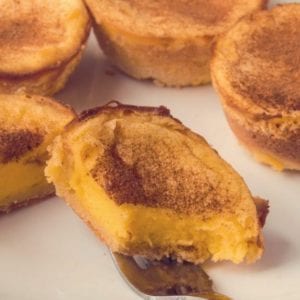
Keto Friendly Custard Tarts
Ingredients
Dough
- 5 oz mozzarella cheese - (fresh, approx. 15% fat)
- 5 tablespoon almond flour
- 2 tablespoon coconut flour
- 4 tablespoon erythritol
- ½ teaspoon baking powder
- ½ teaspoon vanilla extract
- 2 tablespoon butter - (unsalted)
- 1 large egg
Filling
- 6 large egg yolks
- 1 ½ cup heavy cream
- ¾ cup powdered erythritol
- 1/16 teaspoon stevia - (optional or to taste)
- ½ teaspoon xanthan gum - (optional)
- 1 teaspoon Ceylon cinnamon - (to sprinkle on top)
Instructions
Dough
- Preheat the oven to 300°F (180°C) and slightly grease a muffin tin with butter.
- Measure out all the dough ingredients. Take the two flours and baking powder. Combine well with a whisk.
- Melt butter and add vanilla and erythritol. Stir. Whisk the egg with a fork.
- In a microwave safe bowl, melt the mozzarella for 2 minutes at around 400W power. Stir, using a spatula then add the flours and the butter mixture. Mix until combined and add the egg. Stir again until batter is combined and the cheese and dough are completely mixed.
- Reheat for 10 seconds in the microwave. Press and fold some more until the dough is almost entirely one color. You might need to do this with your hands, in which case it is useful to wet them a little.
- Reheat the dough for 10 seconds again. Roll two halves of the dough to the approximate 1/16-inch thickness (help yourself with placing parchment paper beneath and on top of dough). Cut out 12 3 to 4-inch circles and place each into the muffin tin.
- Bake for 10 minutes. The edges should become slightly brown.
Filling
- Keep the oven heated at 300°F (180°C).
- Dissolve the optional xanthan gum in the heavy cream, mixing with an electric mixer just until the mixture gets somewhat thick. If you are not using the xanthan gum, just mix the heavy cream until it gets a little bit thicker. Do not overmix. Add erythritol (and stevia) and stir until the mixture is smooth.
- In a small bowl, blend the yolks with a fork until smooth. Add the yolks to the cream mixture, stirring gently to combine.
- Ladle the egg-cream mixture into the partly baked dough.
- Bake for 20 to 25 minutes. The edges should be puffed but the middle still jiggly. When done, cool completely in the tin. Powder with cinnamon and, for best results, serve and eat the same day. Enjoy!


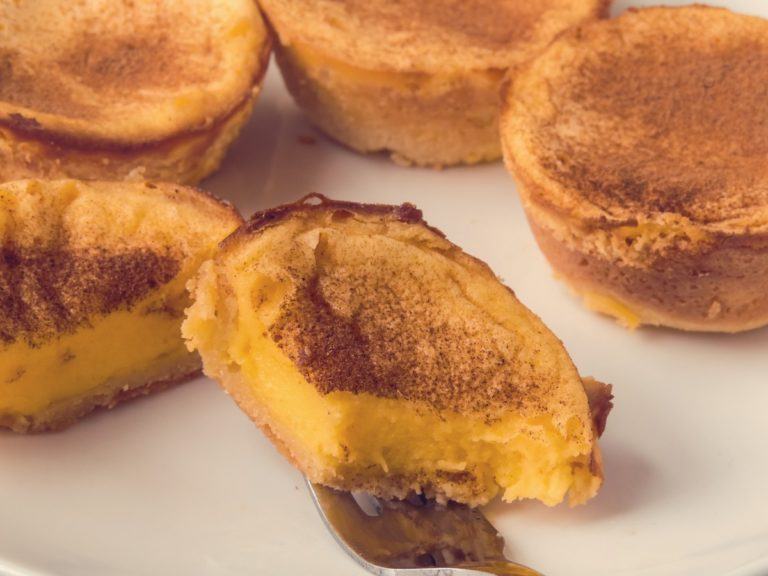




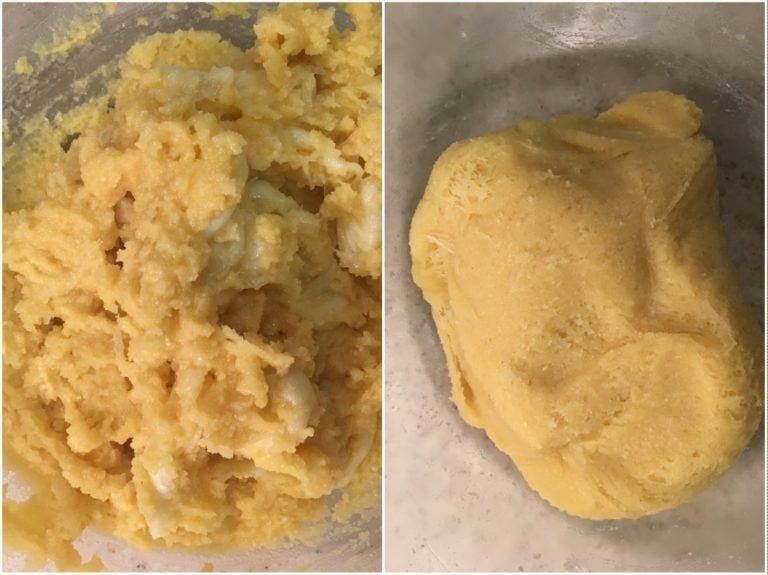







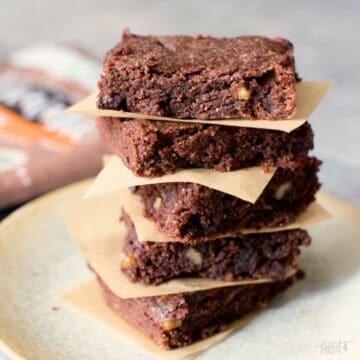
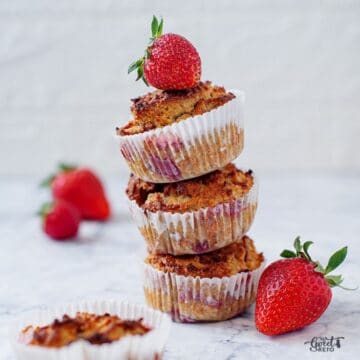
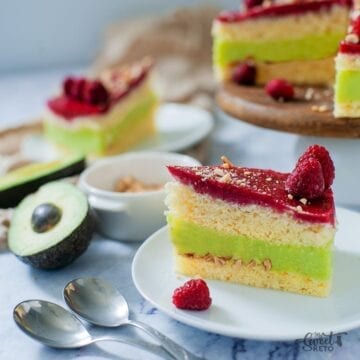

Marie Harwood says
Recipe says preheat oven 300* and to bake the crusts 0 minutes. Then for the filling recipe says keep oven heated at 350*. Does that mean to raise oven temperature to bake after filling for 20-25 minutes or should I keep oven temperature at 300*?
Tisa says
Hi, Marie! I'm sorry that was a typo in the instructions! You should keep the oven temperature at 300°.
Thank you for your question!
C. Videmark says
Re.: mozzarella that won't melt - I've made fathead pizza dough once, using the melting method. It went like Rosalind's dough, and I would neverever bother to make a fathead dough again if it wasn't because I found recipes that used finely grated cheese. So I put everything in my foodprocessor, and it works wonderfully! I will attempt to make this pastry with the chopper method 🙂
Thank you for the info on the sweetness. Good to know! 🙂
My Sweet Keto says
Thank you for the comment! Let us know how the recipe turns out for you. 🙂
Jessie Daniels says
Hi! I only have stevia, and where I live, can't find alternative keto sweeteners. Could I use only stevia in this recipe? I'm dying to try it!
My Sweet Keto says
Frankly, it is hard to say for certain what using solely stevia extract will do in this recipe. The stevia powder brings much less volume and overall dry ingredient count. Moreover, lots of people dislike stevia taste if it is not mixed with erythritol or similar sweetener. This might not be your case, though. 🙂 Have you tried Amazon?
Of course, you can always try the recipe using just stevia, and let us know how it goes!
Rosalind says
Congratulations on the very different approach to creating some pastry! While my initial results fall far short of yours, we think this recipe is worth persevering with. My initial problem was the mozzarella. The crumbly cheese in the bowl in your pic looks very different from ours. Is it fresh mozzarella? I used the packaged stuff as that is what I had on hand, but even the fresh stuff is usually more stringy than yours appears to be. While the mozzarella bubbled a bit around the sides when heated it basically turned into rubber. The recipe does not say when to add the butter/xylitol/vanilla, so I tried to mix it with the combined mozzarella and flours. It was very reluctant to combine, so in the end I put the lot in a milk pan on very low heat and kept prodding and turning it with a spatula until everything combined. The resulting dough rolled out OK but was so rubbery it would not cut with the cookie cutter. In the end I roughly cut out the shapes with scissors. I then discovered that unlike regular pastry, I could not combine the scraps and roll again, so tore the extra bits up and added them around the tops of the circles once they were in the tin (only have a 3"cutter so this worked OK).
Next step that went wrong was my fault: busy with the cream and the xanthan gum, and a loaf I had just taken from the oven, I left the shells in too long and they went quite dark and chewy. (By the way, the psyllium loaf is the ideal recipe to make alongside the tarts as it uses six egg whites and I am welcoming a change from turning the yolks into keto icecream.)
Looking through the recipe beforehand I realised that it caters for a very sweet tooth, so reduced the xylitol accordingly, using half the suggested amount in the pastry and 2 dessert spoons in the custard. We find the end result plenty sweet enough. Even though I used just half the recommended xanthan gum, next time I won't use any at all. It made the cream very goopy and even with the egg yolks mixed in, it would not have ladled into the cases. When cooked some of the oil had separated out of the mozzarella. Overall, I think that the mozzarella has been central to my woes, so if we can clarify that issue, I will give the recipe another go.
My Sweet Keto says
Hi, Rosalind. Firstly, thank you for your thorough and sincere comment. These types of feedback should help me make better recipes and instructions in the future.
I am sorry your "pastry" didn't turn out optimally. You were right; I forgot to mention when to add the butter mixture. But I guess that the main problem really lies in mozzarella cheese. I used fresh mozzarella and didn't give much thought to the pre-shredded packed one since I rarely use it. And even with the fresh type, there are many different options to choose from where I live (Europe), but most of them are around 15% fat, which is what I used. Once, I tried melting it in a conventional oven and had similar problems as you, which got solved using microwaving. When microwaved, it becomes a water-rubber thingy that needs to be combined with all other ingredients. Additional 10-second microwaving is then used as needed to combine all the ingredients quickly, and for easier rolling as well. And yes, the "pastry" is not as easily cut as the real thing. Anyways, you got around it pretty well, I think. I'm wondering if your mozzarella was too high in fat comparing to mine.
Have you ever tried making fat-head pizza? It uses very simal procedure (microwaving mozzarella), and I've used many different types of mozzarella making a fat-head crust; Sometimes it came together easily, sometimes not, but worked out, in the end, every time. Again, I never used the pre-shredded cheese.
As for the sweetness, Xylitol is as sweet as table sugar while erythritol tends to taste 60 to 80% less sweet. So you were right to use less of xylitol. When I make up recipes, I tend to look at ratios of sugar towards other ingredients in non-low carb recipes, and I then use similar rate for erythritol. Which should result in not-too-sweet desserts, but sometimes it doesn't. Admittedly, at times I get lost in wondering what is sweet enough and what is too sweet, using erythritol. I guess one of the problems behind this lies in the fact that keto, LCHF, low-carb folks have different sweetness thresholds as we've got "unused" to consuming sugar.
Thanks again for a constructional comment. As well as for the psyllium loaf idea; I haven't tried that yet. Wishing you many delicious results in the kitchen. 🙂